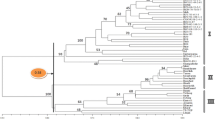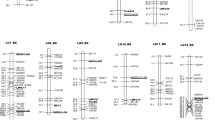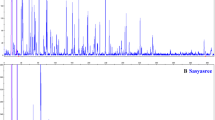Abstract
Amplified fragment length polymorphism (AFLP) analysis is a PCR-based technique capable of detecting more than 50 independent loci in a single PCR reaction. The objectives of the present study were to: (1) assess the extent of AFLP variation in cultivated (Gycine max L. Merr.) and wild soybean (G. soja Siebold & Zucc.), (2) determine genetic relationships among soybean accessions using AFLP data, and (3) evaluate the usefulness of AFLPs as genetic markers. Fifteen AFLP primer pairs detected a total of 759 AFLP fragments in a sample of 23 accessions of wild and cultivated soybean, with an average of 51 fragments produced per primer pair per accession. Two-hundred and seventy four fragments (36% of the total observed) were polymorphic, among which 127 (17%) were polymorphic in G. max and 237 (31%) were polymorphic in G. soja. F2 segregation analysis of six AFLP fragments indicated that they segregate as stable Mendelian loci. The number of polymorphic loci detected per AFLP primer pair in a sample of 23 accessions ranged from 9 to 27. The AFLP phenotypic diversity values were greater in wild than in cultivated soybean. Cluster and principal component analyses using AFLP data clearly separated G. max and G. soja accessions. Within the G. max group, adapted soybean cultivars were tightly clustered, illustrating the relatively low genetic diversity present in cultivated soybean. AFLP analysis of four soybean near-isogenic lines (NILs) identified three AFLP markers putatively linked to a virus resistance gene from two sources. The capacity of AFLP analysis to detect thousands of independent genetic loci with minimal cost and time requirements makes them an ideal marker for a wide array of genetic investigations.
Similar content being viewed by others
References
Akkaya MS, Bhagwat AA, Cregan PB (1992) Length polymorphisms of simple sequence repeat DNA in soybean. Genetics 132:1131–1139
Apuya NR, Frazier BL, Keim P, Roth EJ, Lark KG (1988) Restriction fragment polymorphisms as genetic markers in soybean, Glycine max (L.) Merr. Theor Appl Genet 75:889–901
Bernard RL (1976) United States national germ plasm collections. In: Hill LD (ed) World soybean research. Interstate Printers and Publishers Inc., Danville, Illinois, pp 286–289
Bernard RL, Juvik GA, Nelson RL (1989) USDA soybean germ plasm collection inventory. INTSOY Series Number 31, vol 2
Bowman KD, Hutcheson, K, Odum EP, Shenton LR (1971) Comments on the distribution of indices of diversity. Stat Ecol 3:315–359
Carpenter JA, Fehr W (1986) Genetic variability for desirable agronomic traits in populations containing Glycine soja germ plasm. Crop Sci 26:681–686
Caviness CE, Walters HJ (1975) Registration of Lee 68 soybeans. Crop Sci 15:777
Delanney X, Rodgers DM, Palmer RG (1983) Relative genetic contribution among ancestral lines to North American soybean cultivars. Crop Sci 23:944–949
Doyle JJ, Beachy RN (1985) Ribosomal gene variation in soybean (Glycine) and its relatives. Theor Appl Genet 70:369–376
Keim P, Shoemaker RC, Palmer RG (1989) Restriction fragment length polymorphism diversity in soybean. Theor Appl Genet 77:786–792
Keim P, Beavis W, Schupp J, Freestone R (1992) Evaluation of soybean RFLP marker diversity in adapted germ plasm. Theor Appl Genet 85:205–212
Kiang YT, Chiang YC, Kaizuma N (1992) Genetic diversity in natural populations of wild soybean in Iwate prefecture, Japan. J Hered 83:325–329
Lark KG, Weisemann JM, Matthews BF, Palmer R, Chase K, Macalma T (1993) A genetic map of soybean (Glycine max L.) using an intraspecific cross of two cultivars: ‘Minsoy’ and ‘Noirl’. Theor Appl Genet 86:901–906
Maughan PJ, Saghai Maroof MA, Buss GR (1995) Microsatellite and amplified sequence length polymorphisms in cultivated and wild soybean. Genome 38:715–723
Michelmore RW, Paran I, Kesseli, RV (1991) Identification of markers linked to disease-resistance genes by bulked segregant analysis:a rapid method to detect markers in specific genomic regions by using segregating populations. Proc Natl Acad Sci USA 88:9828–9832
Muehlbauer GJ, Specht JE, Thomas-Compton MA, Staswick PE, Bernard RL (1988) Near-isogenic lines — a potential resource in the integration of convential and molecular marker linkage maps. Crop Sci 28:279–735
Rohlf FJ (1992) NTSYS-pc: Numerical taxonomy and multivariate analysis system. Exeter Software, New York
Rongwen J, Akkaya MS, Bhagwat AA, Lavi U, Cregan PB (1994) The use of microsatellite DNA markers for soybean genotype identification. Theor Appl Genet 90:43–48
Saghai Maroof MA, Soliman KM, Jorgensen RA, Allard RW (1984) Ribosomal DNA spacer length polymorphisms in barley: Mendelian inheritance, chromosomal location, and population dynamics. Proc Natl Acad Sci USA 83:1757–1761
Singh RJ, Hymowitz T (1988) The genomic relationship between Glycine max (L.) Merr.and Glycine soja Sieb. and Zucc. as revealed by pachytene chromosome analysis. Theor Appl Genet 76:705–711
Skorupska HT, Shoemaker RC, Warner A, Shipe ER, Bridges WC (1993) Restriction fragment length polymorphism in soybean germ plasm of the southern USA. Crop Sci 33:1169–1176
Skroch P, Tivang J, Nienhuis J (1992) Analysis of genetic relationships using RAPD marker data. In:Proc Symp Applic RAPD Technol Plant Breed, Minneapolis, Minn Crop Sci Soc Am, Madison, Wisconsin, pp 26–30
Smith TJ, Camper HM (1973) Registration of Essex soybean. Crop Sci 13:495
Smith S, Luk S, Sobral B, Muhawish S, Peleman J, Zabeau M (1994) Associations among inbred lines of maize using RFLP and DNA amplification technologies (AFLP and AP-PCR), and correlations with pedigree, F1 yield and heterosis. Maize Genet Newslett 68:45
Sokal RR, Michener CD (1958) A statistical method for evaluating systematic relationships. Univ Kansas Sci Bull 38:1409–1438
Specht JE, Williams JH (1984) Contribution of genetic technology to soybean productivity — retrospect and prospect. In: Genetic contributions to yield gains of five major crop plants. Am Soc Agron Madison, Wisconsin, pp 49–74
Tingey SV, Rafalski JA, Williams GK (1992) Genetic analysis with RAPD markers. In:Proc Symp Applic RAPD Technol Plant Breed, Minneapolis, Minn Crop Sci Soc Am, Madison, Wisconsin, pp 3–8
Wachira FN, Waugh R, Hackett CA, Powell W (1995) Detection of genetic diversity in tea (Camellia sinensis) using RAPD markers. Genome 38:201–210
Williams JGK, Kubelik AR, Livak KJ, Rafalski JA, Tingey SV (1990) DNA polymorphisms amplified by arbitrary primers are useful as genetic markers. Nucleic Acids Res 18:6531–6535
Young ND, Zamir D, Ganal MW, Tanksley SD (1988) Use of isogenic lines and simultaneous probing to identify DNA markers tightly linked to the Tm-2a gene in tomato. Genetics 120:579–585
Yu YG, Saghai Maroof MA, Buss GR, Maughan PJ, Tolin SA (1994) RFLP and microsatellite mapping of a gene for soybean mosaic virus resistance. Phytopathology 84:60–64
Zabeau M, Vos P (1993) Selective restriction fragment amplifications general method for DNA fingerprinting. European Patent Application No. 0534858 A1
Author information
Authors and Affiliations
Additional information
Communicated by A. L. Kahler
Rights and permissions
About this article
Cite this article
Maughan, P.J., Saghai Maroof, M.A., Buss, G.R. et al. Amplified fragment length polymorphism (AFLP) in soybean: species diversity, inheritance, and near-isogenic line analysis. Theoret. Appl. Genetics 93, 392–401 (1996). https://doi.org/10.1007/BF00223181
Received:
Accepted:
Issue Date:
DOI: https://doi.org/10.1007/BF00223181




